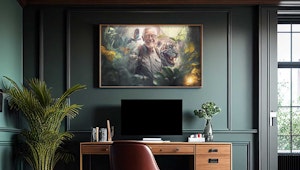How do you make young people think about their future? The solution, according to ING Bank Poland, is to use artificial intelligence to give them a glimpse of what that future might look like. And, in doing so, prompt them to consider saving for their retirement.
This was the logic behind Future Me, an AI-powered campaign, that launched in Poland in January, engaging more than 10,000 young people and leading to a 300 per cent year-on-year increase in retirement products in the first quarter.
Anna Witecka, expert lead of branding at ING Poland, explains: ‘The pension for today’s 20-year-olds is estimated to be one quarter of their final salary, so the future does not look bright for the younger generation. But saving for pensions is not high on their priorities.’
Three factors lay behind such disinterest. Not surprisingly, relatively low-income levels combined with rising inflation plays a role. But there is also a popular belief among young people that, in the end, the state will pay. And finally, it is one of those topics that people want to ‘think about later’.
Speaking to psychologists, ING Bank learned that our brains are programmed to think about the here and now, and find it difficult to imagine the future. ‘We started thinking about that insight and about whether there was a way to start talking about retirement in an engaging way,’ explains Witecka. These discussions coincided with a burst of interest in AI and avators, sparked by the launch of ChatGPT.
The idea of a campaign, created almost entirely by artificial intelligence, took shape.
Young people were simply asked to finish the sentence In the future I will…, answer some supplementary questions and upload a photograph of themselves on a Future Me app or the campaign’s landing page, where they also found information on savings products and video tips from financial experts and psychologists.

And that ‘future’ was painted for them using state-of-the-art generative AI.
Witecka and her team picked the 21 most interesting ideas every day, sending the winners printed versions while one person received their personalised image printed on metal canvas – real-world reminders of their digital futures.
Her personal favourites were futuristic visions of living under the sea, but many imagined traveling the world or spending time with friends and families. Quite a few talked about living in Tuscany, enjoying the food and wine.
It sounds simple, but creative agency GONG claims it took three months to develop the app and workflow, partly because AI models were constantly evolving. Behind the scenes, it translated the plans from Polish into prompts in English, with a pre-defined set of styles and keywords. These were fed into a custom-trained Stable Diffusion, a text-to-image model, which generated photo realistic images.
GONG’s art directors supervised the work to ensure that AI hadn’t gone too crazy, adding extra fingers, for example, and then mixed these images with futuristic worlds generated by Midjourney, using the same prompts.
And in order to make the campaign really stand out, every single campaign asset, including music and videos, were co-created with artificial intelligence. For example, the video script was created by ChatGPT.
More than 10,000 people took part, generating more than 30,000 images, which they shared on Facebook, Instagram and YouTube, prompting more than 55,000 reactions and comments.
‘We didn’t expect the numbers,’ admits Witecka. ‘It was because of AI, which was really helpful because we were talking about something young people see as boring. The personalisation was most important, though, because we were using AI to see futures based on a photo and personal information. It was dedicated to the user.’



